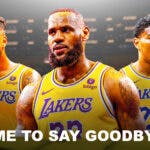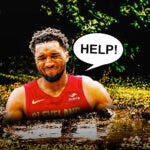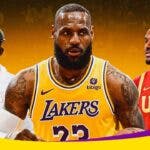It's one of the ultimate what-ifs in NBA history. The Los Angeles Clippers could have drafted Kyrie Irving in 2011 had they protected that draft pick after trading Baron Davis to the Cleveland Cavaliers.
The fallout would have been crazy from a historical perspective, as LeBron James maybe never returns to the Cavaliers due to the fact Kyrie would be on the Clippers.
During a trade deadline in which NBA superstars such as Deron Wiliams and Carmelo Anthony switched teams, it was an under-the-radar deal between two bottom-feeders that would change the course of NBA history. The Clippers ended up gifting the Cavaliers a future All-Star in Kyrie for the sake of salary cap space that they ended up doing almost nothing with. Had the Clippers made the correct move in hindsight, how would their fates have changed?
At 21-37 entering the All-Star break in the 2010-2011 season, the Clippers needed to do something. They had a young star to build around in power forward Blake Griffin, but not much else. The rest of the roster consisted mostly of unproven young players who had plenty of potential but had not lived up to it yet.
Al-Farouq Aminu, the eighth overall pick of the 2010 NBA Draft, was a big part of the Clippers' plans. Eric Bledsoe was taken 18th overall that year and provided solid play off the bench. Shooting guard Eric Gordon was in his third NBA season and would average a career-high 22.3 points that season. Veteran center Chris Kaman made the All-Star Game after averaging 18.5 points and 9.3 rebounds per outing. Kaman's backup, a young reserve center named DeAndre Jordan, rounded out the team's core.
Although the Clippers weren't completely devoid of talent, they had a few problems. One of the biggest was Davis. Before the 2008-2009 season, the Clippers signed the athletic playmaker to a five-year, $65 million contract. Not a bad deal for one of the league's top point guards. Unfortunately, Davis's performance sharply declined, and it became clear that the young, rebuilding Clippers had no use for a now overpaid, aging, and injury-prone star. So, they began to shop him around, but he wasn't exactly a positive asset.
The Cavaliers were still getting over the shock that was LeBron's departure, and they were feeling his absence. They would finish 19-63 and set the record for the longest losing streak in a single season. Their future looked bleak, as the LBJ era had maxed out their salary cap and prevented them from getting high draft picks. However, they did have one valuable player. All-Star guard Mo Williams was in the midst of a solid season, and at 28 years old, was still in the prime of his career.
The Clippers saw Williams as someone who would be an immediate upgrade over Davis and provide a veteran presence to guide the young players. He had been to the NBA Finals and had plenty of experience, so he knows how to win in the NBA. The Clippers made him their primary target and began to negotiate a deal with the Cavaliers.
The final trade was Williams and forward Jamario Moon for Davis and the Clippers' unprotected 2011 first round pick. It seemed like a win for both teams. The Clippers upgraded at PG and shed salary, and the Cavaliers added a leader for their rebuild. But the Clippers used the cap space to sign Randy Foye and Ryan Gomes, who, while decent, did not improve the team enough to make the NBA Playoffs. As a result, that simple trade just netted the Cavaliers another lottery pick.
The rest is history. The Cavaliers won the first and fourth overall picks, drafted Kyrie and Tristan Thompson, and won the NBA championship four years later in LeBron's return. The Clippers, on the other hand, quickly moved on from Williams in favor of superstar Chris Paul.
The trade, even when taken in the context at the time, seems a bit odd for the Clippers. Their record before the All-Star break that season was among the NBA's worst, and they were all but guaranteed to miss the postseason. Was it really that necessary to shed Davis' contract that they had to give up a lottery pick? Even if it were, they could have at least made it top-five or top-10 protected, as the Cavaliers, desperate for draft capital to jumpstart their rebuild, would most likely have still accepted. The pick could then have been made to convey in a later year when the Clippers would most likely be a better team.
If they had done that, the Clippers would have found themselves with the first overall pick, and the best PG prospect in years staring them in the face. Kyrie would have made the CP3 trade unnecessary, and the Clippers would have built around Kyrie, Gordon, Aminu, Jordan, and Griffin. A solid group, especially if Gordon and Griffin don't have the serious injuries that they suffered later on. Plus, if Jamal Crawford still signed with the Clippers, they could run a backcourt of two of the best ball-handlers in NBA history.
On the Cavaliers' side, maybe a player other than Thompson got taken at no. 4 overall in the 2011 NBA Draft. Maybe a player who had the potential to develop into an elite two-way wing but needed some development. Kawhi Leonard leading the Cavaliers' rebuild is an interesting thought. Also, if Kyrie wasn't there, perhaps LeBron would never have returned.
With solid depth, that prospective Clippers would certainly have been an NBA Finals contender by 2015-2016 if the core stayed healthy and intact. Looking back, the Cavaliers certainly won the trade, but the Clippers haven't had too bad of a run either. If they had just protected that pick even a little bit, we would be watching a very different NBA right now.




